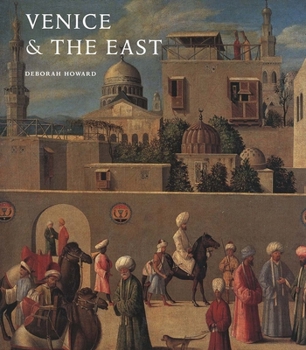Venice and the East: The Impact of the Islamic World on Venetian Architecture, 1100-1500
Precious spices and textiles, imported from distant trading posts in the eastern Mediterranean, stocked Venetian markets in the Middle Ages; but Venice's merchants imported more than material goods... This description may be from another edition of this product.
Format:Hardcover
Language:English
ISBN:0300085044
ISBN13:9780300085044
Release Date:September 2000
Publisher:Yale University Press
Length:300 Pages
Weight:4.40 lbs.
Dimensions:1.1" x 9.5" x 11.3"
Customer Reviews
3 ratings
Venice - the Hong Kong of its time
Published by Thriftbooks.com User , 16 years ago
Venice is nothing like the rest of Italy ... everyone can see this ... instead of looking below the surface most people just describe it as "magical" . Having been there numerous times, it has clear influences from the Islamic world. I also have not seen much that is truely Gothic in the rest of Italy for that matter ... Milano Cathedral being the only real example I've seen. This is a very good book, and anyone who believes that Gothic (with its pointed arches, etc) is not derived from Islamic architecture needs to do some travelling (outside of Europe), and stop believing in magic. Tourists heading to Venice should read this book - and "A History of Venice" by J.J.Norwich and look at the photos (not text - which was translating by Babelfish methinks) in "Palaces of Venice" by A.Fasolo. You will then know that it was a maritime empire populated by entrepreneurial merchants, that made loads of money from having a virtual monopoly of the spice trade from the east (Islamic countries) to Europe, to fund the building of all these great buildings. This all came to an end when Portugal found another way to the east and bypassed Venice. Not unlike Hong Kong being bypassed by Shanghai today.
The Many Veils of Venice
Published by Thriftbooks.com User , 17 years ago
Deborah Howard is steeped in the enigma of Venetian architecture and gives a fabulous interpretation of its development through trading relationships with the Islamic world from 1100-1500 AD. By emphasising the mental `Transmission and Propagation' of Islamic imagery as much as any materialistic one through trade, Howard shows just how elastic the `process of cultural diffusion' was and restores the importance of the oral tradition in the `reformulation' of that imagery into another space and time. Her focus on the Middle East draws our attention away from Constantinople, bringing out the importance of Alexandria as one of the main sources of cultural inspiration. In a vivid example of a rescued and transformed architectural motif, Howard mentions at length the lighthouse Pharos of Alexandria. This wonder of the ancient world was still standing when Islam spread across the North African coast and its secular function as a light in dark places became a potent spiritual symbol with the slimmed down rise of many a minaret. The offspring of Pharos continued to multiply with Venice contributing several of its own; the last example, Codussi's campanile for the cathedral church of San Pietro di Castello with, `its snow-white ashlar masonry . . . stands at the eastern end of the city, as a beacon for the sea borne traveller from the east.' The Great Umayyed Mosque in Damascus also gets singled out for special attention as does the Abbasid and Fatimid periods in general, with their legacy of impressive building projects that impacted upon the mind of many a Venetian merchant. Howard reminds us how the papal ban on trade with Moslems became more than just a tiresome irritant for the Venetians. With so much lucrative trade at stake, the essence of its survival, good relations with the Moslem Middle East were a necessity; in Cairo for example, `only Venetian gold ducats are accepted currency.' Venice also became a facilitator in pilgrim traffic to Jerusalem and it is the combination of so many of those factors that makes Deborah Howard's narrative so interesting. With splendid photographs and maps to reinforce her view, we look at Venice with fresh eyes while the ghost of bygone Alexandria dazzles, mirage like, before us. The ripe old civilisations of the east were infused with much positive creativity in the wake of Islamic conquests: Howard's narrative helps dissolve the rigid and outdated paradigm of a `clash of civilisations,' revealing a grudging sense of admiration by many a Christian merchant and pilgrim who stood witness to Islamic ways of life and became transmitters of that imagery back to Venice. An unusual book: Highly recommended!
Venice's love affair with the Orient
Published by Thriftbooks.com User , 23 years ago
Clearly one of the best art books of the year, Venice and the East traces the impact of Islamic art on the Venetian imagination -- as evident in its architecture. Though stunning illustrations that compare Venetian and Islamic architecture and a well-written text based on primary sources, author Deborah Howard shows that, in the heyday of Levantine trade, Venetian merchants brought back more than spices and cotton from the Islamic world. They also brought back visions of paradise: Islamic styles in gardens, courtyards and palaces that evoked not just Eastern sensuality but also biblical grandeur and spirituality. Although Howard gives ample attention to the borrowing of specific architectural motifs -- balconies, crenellated walls and ogee windows -- she goes well beyond a cataloging of borrowed style. This is, most of all, a study in cultural assimilation -- of ideas as much as architectural form -- and is well worth treasuring whether your passion runs to architecture, history, sociology, or more simply: to gorgeously illustrated coffee table books.





